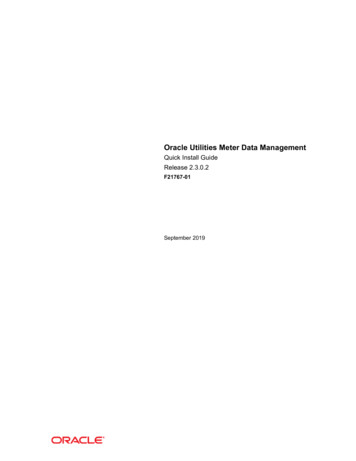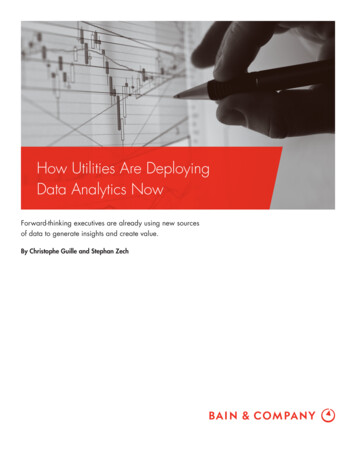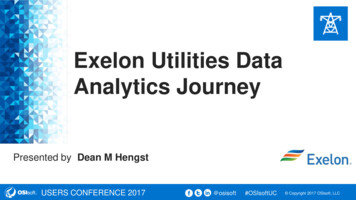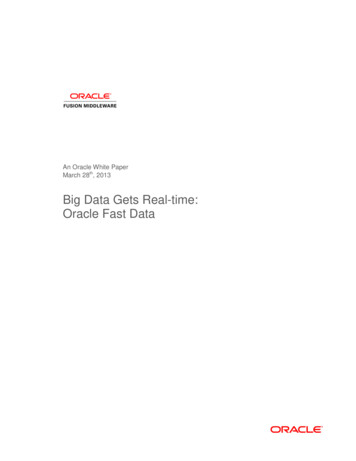
Transcription
Big Data BlackOut: Are UtilitiesPowering Up Their Data Analytics?
Utilities’ Analytics Performance is Under-PoweredBig Data in the utilities sector can only geteven bigger as the smart transformationof the industry accelerates. It is estimatedthat 680 million smart meters will beinstalled globally by 2017 – leading to280 petabytes of data a year1. This BigData surge is an opportunity for utilities todrive new levels of operational efficiencyand transform the customer experience.Take operational efficiency alone. Theannual cost of weather-related poweroutages to the U.S. economy is estimatedto be between 18 billion to 33 billion2.Organizations can use Big Data analyticsto detect operational challenges andprevent outages, substantially reducingcosts. EPB, an American utility, whichestimated that power outages cost thelocal community 100 million, installedautomated fault isolation and servicerestoration technology. During a July2012 storm, automated switching in thedistribution system instantly reduced thenumber of sustained outages by 50%.This innovation, combined with informationon customer outage provided by meters,meant EPB reduced total restorationtime by 1.5 days, representing almost 1.5 million in operational savings andsignificantly reduced costs for customers3.More recently, this sentiment has shifted.Big Data has moved front of mind forutilities executives. Our end-2014 survey– which covered 1,000 senior decisionmakers across 10 countries and nineindustries, including utilities – shows thatfor the utilities industry segment:Are utilities grasping these analyticsopportunities? In recent years, theindustry has appeared hesitant. In 2012,we conducted joint research with the MITCenter for Digital Business to understandthe digital maturity of a range of industries.Our study revealed that utilities had lowdigital maturity and their investment indigital technologies – such as analytics4– was conservative. Subsequent 2013research, in partnership with the MITSloan Management Review, revealed that57% of utilities did not consider analyticsa major opportunity5. 80% of utilities see Big Data analytics asa source of new business opportunities 75% of utilities see Big Data analytics ascrucial for future success (see Figure 1)Figure 1: Utilities’ Perception of Big Data AnalyticsPercentage of Utilities Agreeing With StatementBig Data Analytics ProvidesNew Opportunities for Business80%N 41Source: Capgemini, “Big & Fast Data: The Rise of Insight-Driven Business”, March 2015275%Big Data Analytics isCrucial for Future Success
However, while the industry may nowrecognize the potential of Big Data, itstruggles to translate that into action. Wealso found that only 20% of utilities havealready implemented Big Data analytics.There is a significant group (41%) with noBig Data analytics initiatives (see Figure2). This compares quite unfavorably withtake-up levels in other sectors.If utilities are to step up strategicinvestments and initiatives, it will requirea clear understanding of where longterm value lies. In the following section,we examine some of the key areas forimprovement and how organizations areperforming in taking those opportunities.Only 20% of utilitieshave alreadyimplemented BigData analytics.Figure 2: Utilities’ implementation of Big Data AnalyticsDon’t knowNot implemented BigData analytics7%41%9%6%6%22%22%46%44%36%31%Currently implementingBig Data analytics32%Already implementedBig Data analytics20%23%26%28%UtilitiesFinancial ServicesOil & GasTelcoN 1000Source: Capgemini, “Big & Fast Data: The Rise of Insight-Driven Business”, March 20153
A Significant Big Data Prize, But InvestmentMissing its Target41% of analyticsinitiatives undertakenare still limited to basicanalytics with reportingfunctionality.Advanced Analytics DrivesOperational Efficiency butAdoption is LowAnalytics can help transform a range ofoperational processes. For instance,analytics helps match power generationwith expected demand, manage peakload (peak shaving) through variablepricing, and optimize the integration ofdecentralized energy generation. The useof predictive analytics also helps increaseasset life and performance, while drivingdown overall asset maintenance costs. Asan executive at a UK utility explained, “Wehave a huge amount of fairly old assetsand we can no longer afford to replaceassets based on their age. We now haveto be a lot more scientific in terms of thedecision we make around what to refresh,when to refresh, and what to leave. Theonly way we could do it is by havingproper predictive analytics to understandwhere the problems are going to be andthen tackle those things6.”its wind library – a repository of weather andturbine data – more than 10 fold. It alsoreduced response time for wind forecastinginformation by approximately 97% – fromweeks to hours, while reducing energyconsumption by 40%9. Likewise, PSE&G10estimated that using predictive analyticsmodels to perform proactive replacementof transformers would help bring downthe overall cost of replacement (see insertbelow).Advanced Big Data analytics (predictive /real-time) can provide significant operationalbenefits to the tune of 300 per meterper year, as identified by C3 Energy, anenterprise application software company7.Indeed, an initiative taken by Center PointEnergy USA used predictive and real-timeanalytics to prevent electricity theft, therebysaving almost 2 million8. Similarly, VestasWind Systems, a wind power company inDenmark, implemented a Big Data solutionto optimize the placement of wind turbinesin order to improve power output and assetlife. This solution enabled Vestas to expandDespite the benefits of advanced analytics,adoption levels appear low. Our analysisof over 100 utilities, and interviews withutility industry executives (see researchmethodology at the end of the paper),found that 41% of analytics initiativesundertaken are still limited to basic analyticsPSE&G – Using Analytics to Drive DownTransformer Replacement CostPublic Service Electric and Gas Company (PSE&G) is one of the largest combinedelectric and gas companies in the United States, servicing 1.8 million gascustomers and 2.2 million electric customers. It has assets worth nearly 17bnand a revenue of nearly 8 billion.PSE&G implemented a Computerized Maintenance Management System (CMMS)to assist with repair, replacement and maintenance decisions for assets, includingtransformers and other equipment. It used analytics to generate a condition scorefor transformers based on multiple factors, such as moisture, dielectric strength,combustible gas rate of change, and cooling performance. An asset replacement(predictive) algorithm uses this condition score, and other factors (chronologicalage, spare availability) to determine the appropriate time to replace transformers.PSE&G also employs advanced analytics on real-time sensors to track variousoperational metrics. Usage of analytics has helped the company in identifyingproblems and remediating issues before a failure, saving millions of dollars inequipment failure avoidance. The company has also determined that replacingsome transformers proactively (by using analytics models), rather than reactively,will help it save over 100m over a 25-year period.Source: PSE&G, “Determining True Age of Transformers Through Advanced Analytics”, DistribuTECHSan Diego, CA, February 20154with reporting functionality (see Figure 3).Analytics Drives CustomerSatisfaction but Initiativesare Few and Far BetweenA key challenge facing utilities is lowcustomer satisfaction levels. In ourprevious paper - So Near Yet so Far: WhyUtilities Need to Re-energize Their DigitalCustomer Experience - we took a detailedlook at this issue. The analysis examinedhow the customer experience in utilitiesis sub-optimal and the significant gapbetween what utilities are doing and howsatisfied their customers are11. Analyticsis an opportunity to enhance utilities’understanding of consumption patterns,and improve the customer experiencethrough a variety of means. These includeproviding usage patterns, using predictiveanalytics to minimize outages/improvereliability, and alert customers with usagespikes among others.Advanced Big Dataanalytics can providesignificant operationalbenefits to utilities,to the tune of 300 permeter per year.
Figure 3: Maturity of Analytics Initiatives by Focus AreaEDF Energy usedanalytics to reducecustomer churn,accruing potentialsavings of up to 30 million per year.Conducting extensive analytics ofconsumer sentiment and feedback isanother opportunity. Our earlier researchfound that only 26% of customermentions on social media on the qualityof communication on outages waspositive12. Gulf Power’s experienceshows how analytics can addressthis. The company used analytics toestablish that, with outages, customersatisfaction is highest when power isrestored in the 10-minute window beforethe initial expected restoration timethat was communicated to customers.Interestingly, it found that restoringpower more than two hours before theexpected restoration time ing metrics like this canhelp utilities fix their biggest customerexperience challenges.Improved customer satisfaction leads tohigher retention rates, as an executive at aGerman utility major confirmed. “Analyticslets you contact the customer withpersonalized offers on existing contracts.This definitely improves customerretention,” he explained. Indeed, utilitieslike EDF Energy have used analytics toreduce customer churn, accruing potentialsavings of up to 30 million per year14.Similarly, Endesa reduced customer churnby 50% (see insert below).PredictiveReal-time26%33%41%ReportingN 115Source: Capgemini Consulting AnalysisEndesa Uses Analytics to Reduce Churn By 50%Endesa is a leading electricity dealer and second-largest gas vendor in Spain.The company wanted to acquire and retain customers in a deregulated andhighly competitive energy market. Implementing an analytics solution helped thecompany to segment and better understand its customer base and streamlinecampaign management. This in turn helped build customer loyalty and acquirenew customers. Endesa reduced churn by 50% in two years, reduced customeracquisition costs by 50%, and improved cross-selling. It also furnished Endesawith a 70% reduction in the time required to design new campaigns and generatea target customer list.Source: SAS client case study5
Analytics lets youcontact the customerwith personalized offerson existing contracts.This definitely improvescustomer retention.–Executive in European utilityWe have already outlined how thecustomer experience in utilities hassignificant weaknesses. You wouldtherefore assume that this would be afocus for efforts. However, this is not thecase. Our 2012 research with the MITCenter for Digital Business also showedthat utility firms were already lagging otherindustries in addressing these issues. Thatresearch revealed that roughly half thefirms we surveyed did not use analyticsto target marketing to customers, qualifysales prospects or optimize pricing16.And our current researchb shows thatthis situation persists. We found that twothirds of utilities do not have analyticsinitiatives focusing primarily on thecustomer (see Figure 4).The lack of customer-focused analyticsinitiatives is partly driven by infrastructurelimitations. When utilities are in a nascentstage of upgrading infrastructure, then it isdifficult to improve areas that have a directimpact on the customer experience, suchas predictive asset maintenance, whichcan improve outage management andreliability of supply. Another challenge isthat customer service does not appear tobe a key area of responsibility amongstutility analytics executives. Our researchfound that amongst 1,000 respondentsacross sectors, utilities had the lowest(10%) percentage of analytics executivesthat had customer service as a main areaof responsibility. This compares quiteunfavorably to the pan-industry average of25%. More worryingly, less than 3% of utilityanalytics executives consider customerservice to be the most significant part oftheir role17.Less than 10% ofutilities respondentsbelieve that customerservice is a key area ofresponsibility.bWe performed a comprehensive analysis of theanalytics initiatives of 100 large utilities across NorthAmerica, Europe and Asia Pacific (see researchmethodology at the end of the paper). This analysis isbased on publicly available information.Figure 4: Analytics Initiatives, % of UtilitiesData ManagementOperations & Marketing/Customer ServiceMarketing/Customer Service8%13%21%Operations58%N 100Source: Capgemini Consulting AnalysisNote: Percentage of all utilities in our research that have launched analytics initiatives. The categories of initiatives are mutually exclusive.6
Big Data Outage: What is Holding Back Utilities?The analytics opportunity for utilities isclear, but there continues to be a lackof real impetus and value delivery. Whatis putting the brakes on utilities? Theprimary reasons include concern overhigh costs and the sheer complexity ofdata18 (see Figure 5).Advanced MeteringInfrastructure collectsinformation that cantranslate to as much asa 3,000-fold increase inthe amount of data.Big Data Creates BigStorage and ManipulationCostsAdvanced Metering Infrastructure collectsinformation multiple times every hour, asopposed to the monthly measurement thatwas the norm. That can translate to, in somecases, as much as a 3,000-fold increasein the amount of data utilities would haveprocessed in the past19. For a typicalelectricity utility, the number of triggersto data growth and their correspondingimpact on data requirements are massive(see Figure 6).The massive increase in installations ofsmart meters and the corresponding risein data usage will necessitate significantinvestment in data storage infrastructureand information management programs.Indeed, utility spending on smart gridinfrastructure, of which data centers are key,is expected to cumulatively total hundreds ofbillions in dollars over the next two decades.Figure 5: Top Challenges for Utilities in Implementing Big Data AnalyticsHigh data storage & manipulation costs26%Data complexityDataManagement23%Data access issues18%Data privacy issues13%Skill shortage13%Lack of management support8%Challenges are identified based on responses of surveyed utility executives. The figure represents the percentage of respondents who voted for the challenge as being themost important impediment to analytics implementation.N 41Source: Capgemini, “Big & Fast Data: The Rise of Insight-Driven Business”, March 20157
Figure 6: Triggers to Data Growth and Estimated Increase in Annual Data Intake for a Utility1000 TBNew Devices in the Home Enabled by the Smart MeterHome Energy ManagementAnnual Rate of Intake800 TBAdvance Distribution Automation10Distribution Management9Operation Systems Integration600 TBGrid Visualization and GISDistribution Energy Resources Management (DERMS)400 TBDemand Response/DSM9Substation Automation SystemDistribution Automation200 TB0 TBAMI Deployment12345678Source: EPRI Intelligrid Via Lockheed Martin Presentation, “Solving Big Data Challenges US Electric Utility Industry”, July 2014Note: 1 TB (Terabyte) 1,024 GigabytesUtilities are Struggling withData ManagementOur research found that more than half ofutility executives cited data management– a combination of complexity, accessand privacy – as significant challenges20.Many respondents were concerned that8Big Data sets were too complex to collectand store, and required a lot of time foranalysis. In particular, unstructured datawas highlighted as being too difficult tointerpret. The added concern was thatthe volume of unstructured data hadincreased over the last two years.Apart from complexity, data access andprivacy issues were also cited as the topimplementation challenge21. Data accessissues include silos that prevent datafrom being pooled for the benefit of theentire organization, while data privacyconcerns security and confidentiality ofsensitive data.
Power Surge: How to Ensure AnalyticsDrives Business ValueAs we have seen, utilities – comparedto other industries – have been slow BigData starters. However, the potentialupside, and the achievements of analyticsleaders in the industry, is leading to a seachange in attitudes. Utilities are poisedto increase their investment in analyticsfrom 700 million in 2012 to 3.8 billionin 202022.However, to ensure these investments bearfruit, organizations need to take a structuredapproach. This begins with a realisticanalysis of their analytics maturity levels,where they want to get to, and what theywant to achieve. That framework gives abaseline for key investments and initiatives.Utilities can then identify the right data setsconcepts. These are a very pragmaticand results-driven way of convincingmanagement of the viability and valueof analytics initiatives. As an executiveat a European energy trading firm says,“We implement new analytics packagesin pilots, and use learning from these toscale up the implementation23.” Utilitiesalso need to ensure that they take a “failfast” approach to analytics initiatives. Byonly committing small resource levels,time-boxing the programme and movingfast, many hypotheses can be testedwithout significant business, budget orproject risk.and the smart systems they need, invest inthe right skills, and put in place the right datagovernance model, potentially includingmechanisms such as Chief Data Officer.Within this structured approach, utilitiesshould err on the side of pragmatism.Begin with Small Initiativesthat are Aligned withOrganizational BigData StrategyThe first step that utilities need to take isto understand the “what-for” of their BigData initiatives. Given that utilities havestruggled to define the value of initiatives,they can begin with pilots and proofs ofBig Data Analytics for Utilities – Indicative Use CasesBig Data and analytics can help utilities improve operational efficiency and customer experience. Operational benefits includerevenue assurance, network and production management, demand forecast, asset management, and optimization of supportfunctions. Similarly, analytics helps improve customer experience through customer relationship optimization, proactive marketingand custom offers and services.Marketing and Customer CareProactivemarketingNetwork andproductionmanagementTariff optimizationCustomer basemanagementCustomer basemanagementServices: energymanagementtools, smart homeBrand &communication(e-listening,web analytics,media campaignoptimization)Brand &communication(e-listening, webanalytics,media campaignoptimization)Offer ionSupport functionoptimizationAssetmanagementDemand forecastRevenueassuranceSupply chainReal-time tsElectricity loadoptimizationFraud apacity planning(includingrenewable energy)Network lossprevention9
Figure 7: Analytics Application Areas by MaturityLevel 1Level 2Level 3Reporting & BIPredictiveReal-TimeDemand ForecastingAsset Reliability ModellingPredictive Asset MaintenanceTariff Modelling and SimulationInventory ManagementNetwork Impact ofEmbedded GenerationDistributed SystemPlanning ReportLoad BalancingSelf-Healing GridVoltage RegulationOutage ManagementConsumption ForecastIntelligent Task SchedulingFault Detection andTroubleshootingCustomer Power ConsumptionManagementPhase DetectionOutage ReportingCustomer ProfilingRegulatory ReportsNetwork Loss AnalysisEvents Pattern AnalysisInventory ManagementTheft and Fraud AnalysisNetwork ConsumptionTrend AnalysisSource: Capgemini Consulting AnalysisCarry out an Analysis ofYour Current AnalyticsMaturity Level and WhatYou Are Trying to AchieveOrganizations need to begin with apragmatic assessment of where they are intheir ana
Data analytics Already implemented Big Data analytics ng i cs Utilities Financial Services Oil & Gas Telco Only 20% of utilities have already implemented Big Data analytics. If utilities are to step up strategic investments and initiatives, it will require a clear understanding











